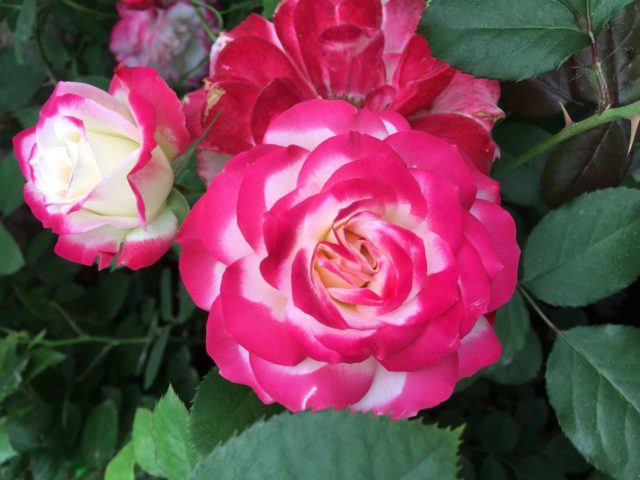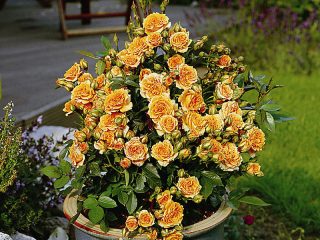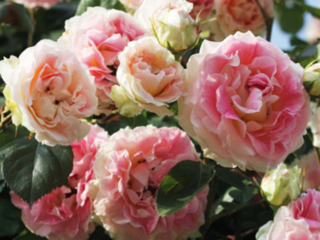Content
- 1 History of selection
- 2 Description of the floribunda rose variety Prince of Monaco and characteristics
- 3 Advantages and disadvantages
- 4 Reproduction methods
- 5 Growing and caring for the rose Jubilee de Prince of Monaco
- 6 Pests and diseases
- 7 Application in landscape design
- 8 Conclusion
- 9 Reviews of the bush rose floribunda Prince of Monaco
Floribundas are bush roses whose flowers are collected in groups located on one stem. They are more resistant to disease and cold than hybrid tea species. Their flowers are double, semi-double and simple, very large, some reaching up to 10 cm in diameter. The floribundas also include the Prince of Monaco rose, a variety from the famous French Meilhan collection.
History of selection
The rose “Prince of Monaco” (Jubile du Prince de Monaco) was bred in France at the very beginning of the century - in 2000, a new rose was demonstrated at one of the flower exhibitions by the Meylan company. At the same time, it was entered into the register and became popular among flower growers. In the process of its creation, the varieties “Jacqueline Nebut” and “Tamango” were used.
Sometimes “Prince of Monaco” is called “Fire and Ice”, this name was given to it because of the original color of the petals - closer to the center they are light, almost white, while the edges are painted red. In the USA it is known under another name - Cherry Parfait.
Description of the floribunda rose variety Prince of Monaco and characteristics
Roses "Prince of Monaco" are distinguished by the duration of their flowering, the first buds bloom in early summer, the last in September. The variety is resistant to unfavorable weather conditions and tolerates drought, rain and cold winters well. They are less susceptible to fungal diseases, unlike other varieties of crops, and to pest attacks.
Rose bush of the Prince of Monaco variety is of average height - 0.7-0.8 m, not spreading, compact. The leaves are thick, dark green, the stems are straight. The flower size is usually 8-10 cm, the color is white with red, the aroma is characteristic, moderately pronounced. On average, each flower consists of 3-4 dozen petals.

The Prince of Monaco variety tolerates rainy weather well, but with high humidity it reduces the quality of flowering
Advantages and disadvantages
Plants of the “Prince of Monaco” variety are unpretentious in care, the cultivation technology is standard, as for representatives of other varieties. They hardly grow in width, so they can be planted very closely with other plants. Roses retain an attractive appearance for a long time both on the bush and cut in water. They can be grown in flowerbeds in open ground and in spacious containers.
The Prince of Monaco variety has no disadvantages, except that some gardeners consider the weak aroma to be a disadvantage. Although in fact, this may be an advantage for people who are allergic to flower scents. In this case, roses can be kept in the house; they cannot cause harm.
Reproduction methods
Bushes of the Prince of Monaco variety are propagated in the same way as roses of other varieties, that is, by cuttings (the main method) and layering. Cuttings of floribunda roses take root easily and take root after transplantation.
They are cut from faded shoots after the first flowering. Each should have 3 nodes.The lower cut is made oblique, the upper cut is made straight. The leaves are cut off from below, leaving 2-3 on top. The cuttings are dipped in a solution of a growth stimulator for half a day, and then planted in the substrate. It should be loose, fertile and breathable. The cuttings are placed in it obliquely, immersing 2/3 into the soil. Cover the top with film to maintain temperature and humidity. Water frequently with warm water so that the substrate is constantly moist. No feeding required. Rooting occurs in 1-1.5 months. Cuttings of the Prince of Monaco variety are planted in a permanent place in the fall, a month before the onset of cold weather, or next spring. In this case, they must be covered with mulch in the fall to protect them from freezing.
Layers are added in the spring next to the bush, without separating them from the plant. Water and fertilize along with it. In the fall, when roots appear on the cuttings, they are dug up and transplanted into a flower bed.

Cuttings are the easiest and most reliable way to propagate roses.
Growing and caring for the rose Jubilee de Prince of Monaco
Floribunda roses love to grow in warm, sunny areas. They do not tolerate drafts and strong winds. It is not recommended to choose a place where roses of other varieties have previously grown, as pathogens or pests may remain in the soil.
For planting in gardens and flower beds on private farms, you need to buy seedlings that are no more than 3 years old. These are still young plants that easily take root and withstand the effects of not the most favorable weather or climatic conditions. We must remember that the older the bush, the worse it will take root.
Planting rose seedlings takes place in the following sequence:
- The area in the flower bed is cleared of remnants of vegetation, dug up and leveled.
- Dig a planting hole 0.7 m wide and at least 0.5 m deep.
- Lay the bottom layer of soil mixture, half consisting of dug up soil, humus and ash.
- Dig in the rose seedling so that the root collar is at soil level.
- Mulch with a layer of plant material.
Caring for the seedling consists of watering and loosening. You need to moisten in the morning or evening, often at first, until the bush takes root. After this, irrigation is necessary only when the soil dries out. Overmoistening should not be allowed; in damp soil the roots may begin to rot. After each watering, you should loosen the soil so that air can flow to the roots.
An adult bush is also watered only on dry soil. Roses are fertilized early in the spring and before flowering begins. Organic matter (humus, compost and ash) and mineral fertilizers can be used as fertilizers. Under each rose bush, add at least a bucket of humus and 1-2 kg of ash. Mineral fertilizers - according to the instructions for the product.
Pruning is carried out after flowering, removing all shoots with buds. In the fall or next spring, they get rid of dry shoots, frostbitten and excess, which thicken the bush. All trimmings are taken out of the rose garden and burned.
Despite the fact that the Prince of Monaco variety is frost-resistant, in the first autumn after planting it is necessary to cover the tree trunk circles with a thick layer of mulching material. It is necessary to cover not only the soil, but also the lower part of the shoots. This is especially important to do in regions with cold winters. In the spring, after the onset of stable warmth, the mulch can be removed.
Pests and diseases
As stated in the description and reviews from gardeners, the floribunda rose “Prince of Monaco” (pictured) is moderately resistant to diseases.The development of diseases most often occurs when the rules of agricultural technology are violated, poor care by the gardener or under unfavorable weather conditions. Roses are especially often affected by rust, powdery mildew and black spot. To fight them, you need to remove all damaged shoots and treat the bush with fungicides.
In addition to fungal diseases, roses can develop chlorosis. Most often, its cause lies not in bacteria, but in plant nutritional disorders, in the lack of any element. Chlorosis can be determined by yellowing of foliage, premature wilting and drying. Control measures: watering or spraying with a solution of fertilizers that contain the necessary element.
Pests that can settle on rose bushes are rose cicada, bronze leafhopper, sawfly and aphid. You can get rid of insects by spraying with insecticides.

The main stage of caring for roses is regular watering.
Application in landscape design
Floribunda roses look good either alone or in small groups. They can be used to form hedges, planted near the walls of buildings and along paths. Roses look beautiful against the background of coniferous plants, creating spectacular compositions with them. When planting, you need to remember that you should not place roses close to the fence, where they will be in the shade and not ventilated. Due to insufficient lighting, plants will not bloom luxuriantly, and due to poor air circulation, they can become infected with fungal infections.
Floribunda roses can be grown in containers and used as a seasonal flower. In winter, such plants should be stored in the cellar.
Conclusion
Rose Prince of Monaco does not have any outstanding features, but undoubtedly has many advantages: unpretentiousness, frost resistance, does not grow tall or wide, and blooms throughout the summer. Plants of this variety can be successfully combined with other roses, decorative annuals and perennials.
Reviews of the bush rose floribunda Prince of Monaco








